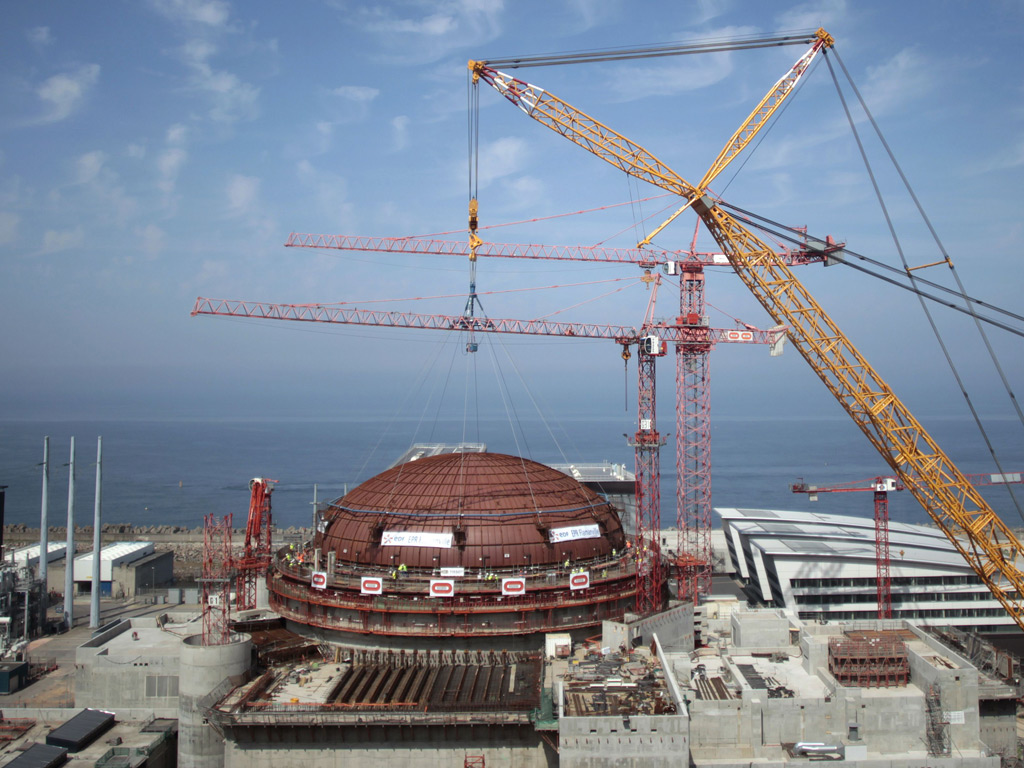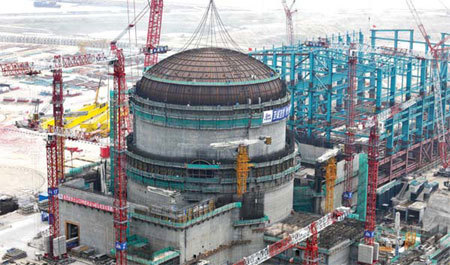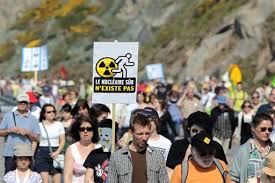
In early April, the troubled French nuclear reactor manufacturer Areva announced that there is an “anamoly” in the reactor pressure vessel installed at Electricite de France’s (EdF) Flamanville reactor currently under construction.
While the U.S. thankfully appears to have avoided any construction of the Areva EPR reactors–the U.S. EPR flagship reactor at Calvert Cliffs-3 was defeated in NRC licensing hearings and EdF has announced it is giving up on the U.S. market–EPRs remain under construction elsewhere, most notably in France, Finland and China. Areva–the world’s largest reactor manufacturer–is already near bankruptcy; if this “anamoly” is endemic to Areva EPRs it could put the final nail in Areva’s coffin.
We appreciate the work of Yves Marignac of WISE-Paris, who prepared the following paper on what the problem is, how extensive it may be and its implications for Flamanville and the rest of the world.
Fabrication Flaws in the Pressure Vessel of the EPR Flamanville-3
Summary
Fabrication defects detected at the end of 2014 in upper and lower heads of the Flamanville-3 reactor pressure vessel are, by size and characteristics, very serious mechanical defaults. These phenomena strongly put into question the safety case of the EPR (European Pressurized Water Reactor) currently under construction in Normandy.
The reason why a well-known material heterogeneity problem was not solved during the forging of the pieces at Areva’s Le Creusot plant has yet to be investigated. The reason why the defects were detected or publicly released so late, at a moment when the pressure vessel was already in place in the reactor building, also needs to be scrutinized.
Areva will face a very difficult challenge in justifying the safety case for the flawed pressure vessel. The only alternative to demonstrating safety in spite of the defects would be to repair or replace the faulty components, which appears hardly feasible and particularly expensive in the case of the bottom piece. Therefore the future of the entire Flamanville-3 project is at stake.
The problem has also international implications, since at least some of the upper and/or lower heads of the Taishan-1 and -2 EPRs, under construction in China, are apparently also affected. It is also not clear whether components destined for the Hinkley Point-C have been fabricated yet and could be concerned.
On the 7th of April 2015, the French Nuclear Safety Authority (ASN) announced that fabrication defects had been found in the reactor pressure vessel (RPV) of the EPR reactor under construction at Flamanville. This information was soon confirmed by the manufacturer of the components, Areva, and the operator, EDF. Additional information was published by ASN on 8 April 2015. The following is a synthesis of this information completed by direct e-mail and phone communication between ASN and WISE-Paris on 9 and 10 April 2015, and some additional research.
Safety Significance of the Reactor Pressure Vessel
The pressure vessel, which hosts the fission reaction of the nuclear fuel, is one of the most crucial pieces of equipment for the safety of a nuclear reactor. This is even more true in the case of the EPR: with a design capacity of 1,650 MWe, its pressure vessel would hold more nuclear fuel, and therefore a higher potential of danger, than any other reactor in the world. In particular, to exclude any breach of the pressure vessel is key in the safety assessment.
Considering the extreme kind of mechanical, hydraulic, thermal and radioactive loads it is exposed to, this imposes very stringent requirements for the mechanical toughness of the pressure vessel. The design pressure is 176 bar and the design temperature is 351°C. The reactor pressure vessel of the EPR is a cylinder of roughly 12.7 meters high and 5.7 meters diameter (7 meters with the nozzles), made of five main parts: three toruses, of which the upper one holds the nozzles connecting the vessel to the primary loops, and the cap-‐shaped bottom which are welded together, plus a separate cap-‐shaped head. Each of these manufactured components as well as the quality of the weldings has to meet specific requirements.
The defects announced on 7 April 2015 concern the pressure vessel head and bottom of the
Flamanville-3 EPR. Unlike the largest parts of the pressure vessel that were forged by Japan Steel Works (JSW–operating the only forge in the world that can process the very large EPR vessel ingots–these smaller parts could be forged by Areva in its plant at Le Creusot.
Nature of the Defect
The vessel closure head is made up of a forged ring, the vessel flange, and a forged partly spherical upper head, penetrated by welded tubes. The lower head is a similar partly spherical forged piece, welded through a forged transition ring to the central core shells. The whole body of the pressure vessel weighs 410 tons, while the vessel head weighs an additional 116 tons.

The pieces are all made of 16MND5 steel. The defect consists in carbon segregation in a certain area of the partly spherical upper and lower heads. It occurs due to insufficient elimination during the forging process of the higher part of the ingot, where carbon tends to concentrate, in the fabricated piece. Why such a well-known phenomenon was not avoided will be, according to ASN, an important part of its examination of the case.
The problem was found recently through destructive tests on a similar vessel head that had been forged in the same conditions. The results are as follows:
• Carbon concentration was found to reach 0.30% in the central area of the forged piece. The fabrication process should ensure, according to the technical specifications applying to 16MND5 steel, that higher concentrations found in the forged piece remain under 0.22%, which is the upper boundary for qualifying materials on the basis of existing studies and return of experience. In other words, as ASN put it, the carbon concentration in the segregated zone brings the material significantly far from the domain of knowledge where the required mechanical properties are well proven.
• This carbon concentration affects the mechanical properties of the material, and most particularly its resilience (its capacity to absorb the energy of a shock, expressed in Joules),which is one of the key properties to be assessed to qualify the pressure vessel. Samples from the segregated zone showed a resilience between 36 J and 64 J, with a mean value of 52 J. This is below the regulatory threshold for the vessel head and bottom, which is of 60 J on average. Taking into account the expected margins, the resilience aimed for and obtained in non-segregated areas is above 100 J.
• The segregated zone is a concentric area with a diameter of around 1.20 meters, on the external face. The depth of the zone remains to be assessed.
Those results are highly likely to be transposable to the head and bottom of the Flamanville-3 pressure vessel, given the very same conditions of their fabrication. Moreover, non-destructive chemical tests on the surface of these parts have confirmed the presence of a similar defect.
Timing of the Process
The ASN was first informed by Areva of the results of the tests in December 2014. These destructive tests were part of the qualification procedure for the components of a pressurized nuclear piece of equipment which the manufacturer has to complete prior to its operation (independently of the whole approval of the reactor start-up, which has to be obtained by the operator).
The head and bottom were apparently forged as early as 2006 (even before EDF obtained the license to create the new reactor at Flamanville, which was granted by a decree in April 2007).
Major defects in the vessel closure head were found by Areva in the Autumn of 2010 and in June 2011. One concerned the welding of adaptor tubes, the other concerned the welding of more than 50 penetrating tubes (out of 107 in total). In October 2011 ASN allowed Areva to carry out deep repair work instead of fabricating a new head. Also some of the tubes probably cross the segregated zone, the reparation process, which is not complete yet, has apparently proceeded without noticing–or taking into account– this problem.
Meanwhile, no such welding issue was raised with the body of the pressure vessel, which was delivered to the Flamanville site in October 2013 and put in place in January 2014. Nevertheless, the destructive testing program, part of the upper and lower head qualification, was only proposed by Areva to ASN in September 2012. Finally, the tests which revealed the segregated zone were only run in October 2014.
It is unclear for the time being why the industrial process went as far as positioning the pressure vessel in the reactor pit and pursuing the construction around it for many months, when these qualification tests had not even started. This questions both the reason why Areva failed to spot this very important problem at an earlier stage, and the reason why EDF did proceed while qualification was not complete. According to ASN, the reasons for the late testing will be part of the investigation.
Regulatory Issue
Once fully constructed, the EPR reactor in Flamanville-3 would require a final operating license, delivered by ASN under the nuclear regime, to start commercial operation. Prior to that operating license, all pressurized nuclear equipment of the plant, starting with the pressure vessel, must be approved under specific regulations reinforced in 2005. Although previous requirements could have been applied during an exemption period granted in the 2005 ministerial order, ASN made it clear that 2005 regulation fully applies as Areva never asked for such an exemption.
The regulation requires that the manufacturer demonstrates that the pressure vessel meets all the mechanical specifications, of which resilience is an important part. Regarding the parts concerned with the defects, the regulation requires Areva either to prove that the vessel head and bottom meet the mechanical criteria, including an average resilience of 60 J, or to justify that it reaches an equivalent safety level by other means.
Theoretically, there is therefore room for the defective pressure vessel to be qualified through alternative proofing, although the nature and size of the problem will likely make it very difficult, if not impossible. It should also be noted that since vessel head and bottom are not subject to the same operational constraints, the technical assessment could reach different conclusions regarding the acceptability of the two pieces of equipment. In particular, the tube penetrations through the vessel head, needed for the control rods and other instrumentation, introduce further potential weaknesses on welded parts while increasing the mechanical constraints. The lower head, on the contrary, is free of such openings (which is an important change introduced in the design of EPR, compared to previous French reactor designs that had instrumentation penetrations in the bottom plates).
The first step in the reassessment process will be a new series of tests that has already been announced. Areva has proposed a testing program to ASN, which the authority has yet to approve. This will likely consist of further destructive tests on the similar head, which has already been used. These new tests will specifically aim for a more detailed characterization of the defect.
Areva will also need to reinforce the demonstration regarding the transposability of these findings to the actual head and bottom of the Flamanville-3 EPR. Although the program has yet to be discussed, the French Minister of Ecology already announced that the results are expected by October 2015. The ASN will then consider the justification case which Areva will build upon these results. Whether this could be conclusive, one way or the other, and when ASN could come to a final decision are still open questions.
Another open question is the regulatory status of such a decision and whether and how this could be challenged either by the industrial stakeholders or the project opponents, depending on the outcome. In particular, should a positive decision be granted on the basis of a modified justification, this could fall under the regulatory requirement to start a new license, going through a public inquiry, etc. Also, one important issue will be to clarify who would bear the responsibility either to stop the project or to start the reactor in such a context.
Alternative Options

If Areva fails to provide a convincing alternative proof to complete the safety case, then the only alternative option is to repair or replace the faulty pieces. The fabrication of a new pressure vessel head would be possible. Regarding the lower head, it is technically very unlikely either to separate it from the whole pressure vessel for replacement or to repair it in situ. Any repair or replacement would therefore almost certainly need the entire pressure vessel to be removed, which would be unprecedented and seems very challenging given the progress of work and lack of space inside the reactor building.
The technical hurdles which any repair or replacement solution for the pressure vessel bottom would need to get over, and the major new safety issues related, come with huge costs and high uncertainty. The feasible alternatives, if any, will raise serious issues of profitability. In other words, economic scenario assessments might show that abandoning the project is cheaper than repair or replacement options, when factors such as the financial costs of further significant delays, or the savings on decommissioning costs if the reactor doesn’t go nuclear, are included.
International impact
The question also arises of the potential impact on other EPR projects where similar defects could be found. There is no particular reason to believe that any vessel head and bottom which has been forged by Japan Steel Works would present the same defect. This is the case of those used for the pressure vessel of the Finnish EPR at Olkiluoto, which are therefore not concerned.
On the contrary, upper or lower heads for other EPRs which have been forged at Le Creusot are expected to be as defective. Although it is still not clear how many and which ones, some of the four parts consisting of the two heads and bottoms of the pressure vessels of Taishan-1 and -2 in China are concerned. One important issue will be the consistency of the technical assessments and the decisions taken by the safety authorities between France and China.
It also remains to be clarified, whether head(s) and bottom(s) already have been forged for the Hinkley Point‐C project in Great Britain or even that of Jaïtapur in India, and if so whether they were forged at Le Creusot.
Yves Marignac, Director of WISE-Paris
Mail: yves.marignac@wise-paris.org
April 13, 2015
Permalink: https://www.nirs.org/2015/04/13/the-epr-anamoly/
Your contributions make publication of GreenWorld possible. If you value GreenWorld, please make a tax-deductible donation here and ensure our continued publication. We gratefully appreciate every donation of any size.
Comments are welcome on all GreenWorld posts! Say your piece. Start a discussion. Don’t be shy; this blog is for you.
If you’d like to receive GreenWorld via e-mail, send your name and e-mail address to nirs@nirs.org and we’ll send you an invitation. Note that the invitation will come from a GreenWorld@wordpress.com address and not a nirs.org address, so watch for it. Or just put your e-mail address into the box in the right-hand column.
If you like GreenWorld, help us reach more people. Just use the icons below to “like” our posts and to share them on the various social networking sites you use. And if you don’t like GreenWorld, please let us know that too. Send an e-mail with your comments/complaints/compliments to nirs@nirs.org. Thank you!
GreenWorld is crossposted on tumblr at https://www.tumblr.com/blog/nirsnet




Reblogged this on nuclear-news.
Thanks for DETAILS missing from recent 2016 Nov news articles.